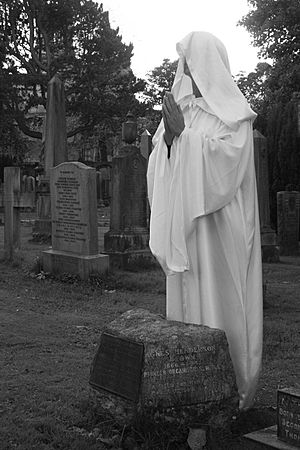Agnes Brown (suffragist) facts for kids
Quick facts for kids
Agnes Henderson Brown
|
|
|---|---|

1916 newspaper cutting
|
|
| Born | 12 April 1866 |
| Died | 1 December 1943 (aged 77) Edinburgh, Scotland, United Kingdom
|
| Nationality | British |
| Other names | Nannie |
Agnes Henderson Brown (born April 12, 1866 – died December 1, 1943) was a Scottish woman who worked hard for women's rights. People often called her Nannie Brown. She was a suffragist, meaning she believed women should have the right to vote. Agnes was also a writer.
She became well-known as one of the "Brown Women." This group walked a very long distance from Edinburgh to London in 1912. Agnes was also one of the first women in Scotland to ride a bicycle. Later, she repeated her long walk, starting even further north in Scotland, from John O' Groats. She also helped start the Scottish Women's Rural Institute.
Contents
Agnes Brown's Early Life
Agnes Brown was born in Edinburgh, Scotland, in 1866. Her parents were William Brown and Jessie Wishart Henderson. Her father, William, was a strong supporter of women's rights. He even went to jail because he disagreed with unfair tax laws for men and women.
William Brown owned several fruit shops. He made sure his daughters, Agnes and Jessie, were well-educated. He taught them to stand up for what they believed in. He even wrote a book about his experiences.
Fighting for Women's Rights
Agnes was an active member of the Women's Freedom League. This group was formed in 1907. They wanted women to have the right to vote.
The "Brown Women" Walk
Agnes volunteered to be one of the "Brown Women." They were called this because of the brown coats they wore, not after Agnes herself. The idea for this walk came from Florence Gertrude de Fonblanque. In 1912, Florence, Agnes, and four other women, including Sarah Benett, started walking from Edinburgh. Their goal was to reach London.
They wore white scarves and green hats. As they walked, they collected signatures for a petition. This petition asked for women's voting rights. The walkers had to walk about 15 miles each day. They also attended meetings every day to talk about their cause. The journey to London took them five weeks.
They followed the route of the A6 road. Other people joined them along the way. One day, near Berwick, they walked over 30 miles! They were welcomed by a local Member of Parliament. Finally, on November 16, they arrived in London. They went to Trafalgar Square where they were greeted with music.
An American supporter named Rosalie Gardiner Jones was inspired by these walks. She organized similar "suffrage hikes" in America. One of her famous hikes was to Albany, New York, in December 1912.
Supporting Men in the Movement
Agnes's father had been jailed for his beliefs. This made her believe that men should also be part of the Women's Freedom League. In 1913, a group of professional men tried to meet with the Prime Minister, Mr. Asquith. They wanted to discuss giving women the vote. When they couldn't get a meeting, they formed the Northern Men's Federation for Women's Suffrage. Agnes volunteered to be their secretary.
Helping Scottish Communities
In 1917, Agnes became an organizer for the Scottish Women's Rural Institutes. These groups helped with farming in Scotland. Later, in 1918, Agnes helped start the Edinburgh Women Citizens Association. Many similar groups were created across the country. Their goal was to teach new women voters about politics and their rights. Other members included Sarah "Sally" Siddons, Lillias Tait Mitchell, Agnes Syme Macdonald, and Alexi Buttar Jack.
Later Life and Legacy
Agnes Brown was a talented writer. She wrote articles, plays, and stories. Some of her stories, like "The Stockin'," were even turned into plays by Elizabeth Finlayson Gauld.
She was also part of different clubs, like the Edinburgh Dickens Fellowship. Agnes learned to type and to ride a bicycle. She loved walking throughout her life. After the "Brown Women" walk, she did another long walk. This time, she started from John O' Groats, the very top of Scotland. She walked all the way to London again. She wrote about her journey in the Weekly Scotsman newspaper.
Agnes Brown passed away on December 1, 1943. She was buried with her parents in Dean Cemetery in Edinburgh. In 2014–15, the Scottish Saltire Society recognized her as an "Outstanding Woman of Scotland."
See also
 In Spanish: Agnes Brown para niños
In Spanish: Agnes Brown para niños


